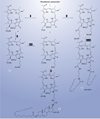Evaluation of bacteriochlorophyll-reconstituted low-density lipoprotein nanoparticles for photodynamic therapy efficacy in vivo
- PMID: 21542686
- PMCID: PMC3137792
- DOI: 10.2217/nnm.11.8
Evaluation of bacteriochlorophyll-reconstituted low-density lipoprotein nanoparticles for photodynamic therapy efficacy in vivo
Abstract
Aim: To evaluate the novel nanoparticle reconstituted bacteriochlorin e6 bisoleate low-density lipoprotein (r-Bchl-BOA-LDL) for its efficacy as a photodynamic therapy agent delivery system in xenografts of human hepatoblastoma G2 (HepG2) tumors.
Materials & methods: Bchl-BOA was encapsulated in the nanoparticle low-density lipoprotein (LDL), a native particle whose receptor's overexpression is a cancer signature for a number of neoplasms. Evaluation of r-Bchl-BOA-LDL as a potential photosensitizer was performed using a tumor response and foot response assay.
Results & discussion: When compared with controls, tumor regrowth was significantly delayed at injected murine doses of 2 µmole/kg r-Bchl-BOA-LDL after illumination at fluences of 125, 150 or 175 J/cm(2). Foot response assays showed that although normal tissue toxicity accompanied the higher fluences it was significantly reduced at the lowest fluence tested.
Conclusion: This research demonstrates that r-Bchl-BOA-LDL is an effective photosensitizer and a promising candidate for further investigation.
Conflict of interest statement
The authors have no other relevant affiliations or financial involvement with any organization or entity with a financial interest in or financial conflict with the subject matter or materials discussed in the manuscript apart from those disclosed.
No writing assistance was utilized in the production of this manuscript.
Figures






Similar articles
-
High payload delivery of optical imaging and photodynamic therapy agents to tumors using phthalocyanine-reconstituted low-density lipoprotein nanoparticles.J Biomed Opt. 2005 Jul-Aug;10(4):41203. doi: 10.1117/1.2011429. J Biomed Opt. 2005. PMID: 16178627
-
Mannose-functionalized mesoporous silica nanoparticles for efficient two-photon photodynamic therapy of solid tumors.Angew Chem Int Ed Engl. 2011 Nov 25;50(48):11425-9. doi: 10.1002/anie.201104765. Epub 2011 Oct 4. Angew Chem Int Ed Engl. 2011. PMID: 21976357 No abstract available.
-
Characterization of biodegradable poly(D,L-lactide-co-glycolide) nanoparticles loaded with bacteriochlorophyll-a for photodynamic therapy.Photomed Laser Surg. 2007 Oct;25(5):428-35. doi: 10.1089/pho.2007.2089. Photomed Laser Surg. 2007. PMID: 17975957
-
An insight on the role of photosensitizer nanocarriers for Photodynamic Therapy.An Acad Bras Cienc. 2018;90(1 Suppl 2):1101-1130. doi: 10.1590/0001-3765201720170800. An Acad Bras Cienc. 2018. PMID: 29873674 Review.
-
Inorganic nanoparticles for enhanced photodynamic cancer therapy.Curr Drug Discov Technol. 2011 Sep;8(3):250-68. doi: 10.2174/157016311796798982. Curr Drug Discov Technol. 2011. PMID: 21644924 Review.
Cited by
-
Photodynamic Efficiency: From Molecular Photochemistry to Cell Death.Int J Mol Sci. 2015 Aug 31;16(9):20523-59. doi: 10.3390/ijms160920523. Int J Mol Sci. 2015. PMID: 26334268 Free PMC article. Review.
-
Lipoprotein-Related and Apolipoprotein-Mediated Delivery Systems for Drug Targeting and Imaging.Curr Med Chem. 2015;22(31):3631-51. doi: 10.2174/0929867322666150716114625. Curr Med Chem. 2015. PMID: 26180001 Free PMC article. Review.
-
Near-infrared fluorescent imaging of metastatic ovarian cancer using folate receptor-targeted high-density lipoprotein nanocarriers.Nanomedicine (Lond). 2013 Jun;8(6):875-90. doi: 10.2217/nnm.12.137. Epub 2012 Oct 15. Nanomedicine (Lond). 2013. PMID: 23067398 Free PMC article.
-
Modular nanotransporters: a multipurpose in vivo working platform for targeted drug delivery.Int J Nanomedicine. 2012;7:467-82. doi: 10.2147/IJN.S28249. Epub 2012 Feb 2. Int J Nanomedicine. 2012. PMID: 22346349 Free PMC article.
-
Low-density lipoprotein-mediated delivery of docosahexaenoic acid selectively kills murine liver cancer cells.Nanomedicine (Lond). 2014 Jul;9(14):2123-41. doi: 10.2217/nnm.13.187. Epub 2014 Jan 7. Nanomedicine (Lond). 2014. PMID: 24397600 Free PMC article.
References
-
- Sitnik TM, Henderson BW. The effect of fluence rate on tumor and normal tissue responses to photodynamic therapy. Photochem. Photobiol. 1998;67:462–466. - PubMed
-
- Triesscheijn M, Baas P, Schellens JHM, et al. Photodynamic therapy in oncology. Oncologist. 2006;11:1034–1044. - PubMed
-
- O’Connor AE, Gallagher WM, Byrne AT. Porphyrin and nonporphyrin photosensitizers in oncology: preclinical and clinical advances in photodynamic therapy. Photochem. Photobiol. 2009;85:1053–1074. - PubMed
-
- Juzeniene A, Peng Q, Moan J. Milestones in the development of photodynamic therapy and fluorescence diagnosis. Photochem. Photobiol. Sci. 2007;6:1234–1245. - PubMed
Publication types
MeSH terms
Substances
Grants and funding
LinkOut - more resources
Full Text Sources
Other Literature Sources
